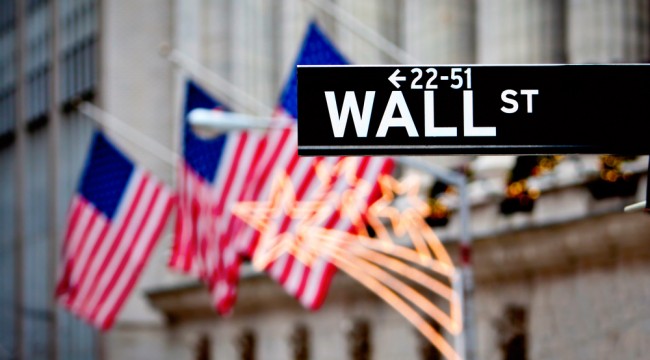In Washington, Is the Glass(-Steagall) Half Empty or Half Full?
by Nomi Prins, DailyReckoning:
 Donald, listen, whatever you’ve done so far, whatever you’ve messed up, there’s one thing you could do that would make up for a lot. It would be huge! Terrific! It could change our world for the better in a big-league way! It could save us all from economic disaster! And it isn’t even hard to grasp or complicated to do. It’s simple, in fact. Reinstitute the Glass-Steagall Act. Let me explain.
Donald, listen, whatever you’ve done so far, whatever you’ve messed up, there’s one thing you could do that would make up for a lot. It would be huge! Terrific! It could change our world for the better in a big-league way! It could save us all from economic disaster! And it isn’t even hard to grasp or complicated to do. It’s simple, in fact. Reinstitute the Glass-Steagall Act. Let me explain.
In the world of romance, if you break up with someone, it’s pretty simple (emotional complications aside). You’re just not together anymore. In the world of financial regulation, it used to be as simple as that, too. It was like installing a traffic light at a dangerous intersection to avoid deaths. In 1933, when the Glass-Steagall Act was passed, it helped break up the biggest banks of the day and for good reason: they had had a major hand in triggering the most disastrous economic depression our country ever experienced.
Certain divisions of those banks were no longer allowed to coexist with others. The law split the parts of banks that placed bets by creating and trading certain risky securities and those that took deposits and provided loans. In other words, it ensured that the investment bank and the commercial bank would no longer cohabit. Put another way, it separated bankers with a heinous gambling habit from those who only wanted a secure nest egg. It was simplicity itself.
After 1933, the gamblers and savers went their separate ways, which proved a boon for the economy and the financial system for nearly seven decades. Then legislators, lobbyists, bankers, and regulators started to chisel away at the wall separating those two kinds of banks. By November 1999, President Bill Clinton signed into law the Gramm-Leach-Bliley Act that repealed the Glass-Steagall Act totally. The abusive marriages of gamblers and savers could once again be consummated.
And who doesn’t remember the result: the financial crisis of 2007-2008 that led to taxpayer-funded bailouts, subsidies, loans, and sweetheart fraud-settlement deals. Just as the Crash of 1929 had been catalyzed by the manufacturing of shady “trusts” stuffed with shady securities, this crisis was enabled by the big banks that engineered complex assets stuffed with subprime mortgages and other loans that were sold around the world.
Under President Obama, the 2010 Dodd-Frank Act was signed into law. The Act sought to limit the ability of big banks to trade the riskiest types of securities. Through inclusion of something called the “Volcker Rule,” Dodd-Frank prohibited the trading of securities (even if with many loopholes). What it didn’t do was actually break up the big banks again. That meant another 1933 still awaited its moment.
Then along came the bizarre 2016 presidential election campaign during which, strangely enough, Democrats and Republicans found one issue on which they had some common ground: the banking system. Key figures in both parties agreed that it was time to stop the investment bank and the commercial bank from commingling. Bernie Sanders ran on a campaign to break up the banks — and so did Donald Trump. At at an October campaign rally in Charlotte, North Carolina, Trump even stated, “It’s time for a twenty-first-century Glass-Steagall.”
The Democratic National Committee platform offered a similar message. “Banks,” it said, “should not be able to gamble with taxpayers’ deposits or pose an undue risk to Main Street. Democrats support a variety of ways to stop this from happening, including an updated and modernized version of Glass-Steagall as well as breaking up too-big-to-fail financial institutions that pose a systemic risk to the stability of our economy.”
The Republican National Committee wasted even fewer words making the point in their platform: “We support reinstating the Glass-Steagall Act of 1933 which prohibits commercial banks from engaging in high-risk investment.” And it didn’t even suggest that the act should be “modernized” or mention a “twenty-first-century” version that didn’t do what the twentieth century one had done.
For the first time since its repeal, in other words, a return to the Glass-Steagall Act had bipartisan support. It couldn’t have been simpler, right? Two parties, one idea: split banks into two pieces. But then, as if you hadn’t already guessed, it got complicated.
Breaking-up, Republican-Style
In the new administration, two key figures are now offering quite different and conflicting views of what a resurrection of the Glass-Steagall Act might mean. At his Senate confirmation hearings, Steven Mnuchin, former Goldman Sachs partner and Trump’s nominee to be secretary of the Treasury, faced Senator Maria Cantwell (D-Wash.) as she bluntly asked “Do you support returning to Glass-Steagall?”
He replied, “I don’t support going back to Glass-Steagall as is. What we’ve talked about with the president-elect is perhaps we need a twenty-first-century Glass-Steagall. But, no, I don’t support… taking a very old law and say we should adhere to it as is.”
Cantwell then pressed him further: “And so, is that the position of what the Republican platform was? Because I thought it was Glass-Steagall?”
To this, Mnuchin responded, “Again, the Republican platform did pass at the convention Glass-Steagall and… [when] we talked about policy with the president-elect, our view is we need a twenty-first-century Glass-Steagall.”
The skepticism in the room was thick enough to cut with a knife. Here, after all, was a man who had made windfall profits on the fallout from the 2007-2008 “too big to fail” financial crisis by organizing a cadre of hedge-fund billionaires to buy the collapsed IndyMac Bank at a discount. He then proceeded to foreclose on some of its mortgages and resellit for a $2.5 billion profit. Why should such a man want to restrict banking activity, Glass-Steagall-style, when his loan practices had allowed him to make a fortune off the taxpayer bailouts that were the result of not doing so? What would the point be when a crisis, as history had just shown, forced the federal government to subsidize risk and failure?
The only problem he faced: the Republican platform said he should.
Last month, testifying before the Senate Banking Committee and under questioning from Senator Elizabeth Warren, he backtracked even further: “The president said we do support a ‘twenty-first-century Glass-Steagall,’ that means there are aspects of it that we think may make sense. But we never said before we support a full separation of banks and investment banking.”
Warren responded incredulously, “Tell me what twenty-first-century Glass-Steagall means if it doesn’t mean breaking up those two parts. It’s an easy question.”
Mnuchin replied, “It’s actually a complicated question… We never said we were in favor of Glass-Steagall. We said we were in favor of a twenty-first-century Glass-Steagall. It couldn’t be clearer.” Which, of course, couldn’t have been murkier.
And then there’s that other former Goldman Sachs man, Gary Cohn, Trump’s director of the National Economic Council. He had quite a different Glass-Steagall tale to tell Senator Warren. According to Bloomberg News, he insisted that he “generally favors banking going back to how it was when firms like Goldman focused on trading and underwriting securities, and companies such as Citigroup Inc. primarily issued loans.” That sounds a lot like breaking up the banks.
This division and the as-yet unresolved nature of the Trump administration response to the Glass-Steagall question could, in the face of another financial crisis, come back to haunt us all, if it translates into more bailouts and systemic failures.
The Democrats’ Dilemma
As with the proverbial difficulty of chewing gum and walking at the same time, certain Democrats seem to find the very idea of supporting both Dodd-Frank and a new Glass-Steagall Act perplexing. Many of them have promoted the idea that no big bank actually failed in the Great Recession moment (which was true only because those banks got huge infusions of federal aid to remain solvent). As a result, they avoided all responsibility for the way the repeal of Glass-Steagall allowed too-big-to-fail banks to come into existence in the first place.



